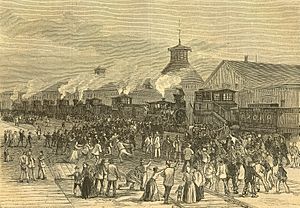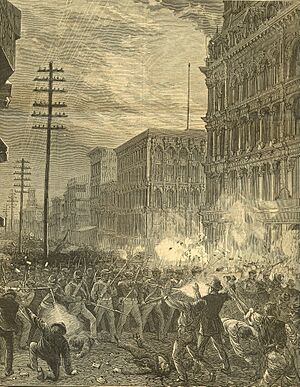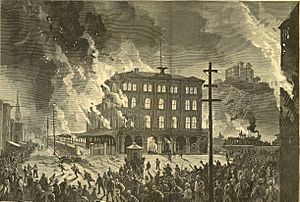Great Railroad Strike of 1877 facts for kids
Quick facts for kids Great Railroad Strike of 1877 |
|||
|---|---|---|---|

Blockade of engines at Martinsburg, West Virginia, 16 July 1877
|
|||
| Date | July 14 – September 4, 1877 | ||
| Goals | Wage increases | ||
| Methods | Strikes, protests, demonstrations | ||
| Parties to the civil conflict | |||
|
|||
| Lead figures | |||
|
|
|||
The Great Railroad Strike of 1877, also called the Great Upheaval, was a huge event in American history. It started on July 14, 1877, in Martinsburg, West Virginia. Workers for the Baltimore and Ohio Railroad (B&O) were upset. The company had cut their pay three times in one year.
This strike was the first time a labor protest spread across many states in the U.S. Workers in states like New York, Pennsylvania, Maryland, Illinois, and Missouri joined in. About 100,000 workers took part.
The strike lasted 52 days. It ended when the government sent in federal troops and the National Guard. About 100 people died during the unrest. Workers burned railroad buildings and trains in some cities. Some people worried it was a revolution.
At this time, workers did not have strong trade unions. City and state governments used militias and troops against the workers. After the strike, many cities built armories. These buildings helped local National Guard units. They were a sign of efforts to stop future worker protests.
The B&O railroad later started programs to help its employees. These included benefits for sickness and a pension plan. This showed that public attention on workers' rights had grown.
Contents
Why the Strike Happened
The United States faced a big economic problem called the Long Depression. It started with a financial crisis in 1873. Many banks failed, and the stock market closed for a while.
This led to high unemployment. By 1876, 14% of people were out of work. Many others had fewer hours. Wages dropped a lot. Thousands of businesses failed.
Before this, railroads grew very fast after the Civil War. About 35,000 miles of new track were built. Railroads were the second-largest employer. But this growth was too fast. Many companies invested too much money.
When the economy crashed, railroad companies struggled. They cut workers' wages to save money. By 1877, workers had faced 10% wage cuts. They also worked in poor conditions. This made them very angry at the railroad owners.
Workers started to stop trains from moving. This affected other parts of the economy. Governments used force to stop these strikes. But workers kept trying to organize. They wanted better pay and conditions.
Many new workers were immigrants. They joined groups like the Knights of Labor. This group grew to 700,000 members. Later, Samuel Gompers started the American Federation of Labor. These groups worked for workers' rights.
The Strike Spreads
The strike began when the B&O Railroad cut wages again. On July 14, workers in Martinsburg, West Virginia, stopped freight trains. A crowd supported them.
The police could not stop the protests. So, the West Virginia Governor sent in militia forces. A militiaman and a striker were wounded in a fight. The striker died. The militia could not get the trains moving.
The governor then asked President Rutherford Hayes for federal troops. Hayes sent them. The strike then moved to Baltimore and Pittsburgh.
Maryland's Struggle
The strike spread to Cumberland, a major railroad center. Workers there stopped all train traffic.
In Baltimore, the Maryland National Guard was called in. They were asked to help by the B&O president. One group of soldiers marched to the B&O station. Another group, the Sixth Regiment, had to fight its way through angry crowds.
Along Baltimore Street, the march turned violent. The soldiers fired on the crowd. They killed 10 civilians and wounded 25. Rioters injured soldiers and burned parts of the train station. President Hayes sent 2,000 federal troops and 600 U.S. Marines to Baltimore. They helped bring order back.
New York's Protests
Strikes also happened in Albany, Syracuse, and Buffalo, New York. On July 25, workers in Albany threw things at a train. When soldiers arrived, the crowd threw things at them too.
The mayor later removed the soldiers. He ordered local police to protect the rail lines. People in cities were angry at railroads. The trains cut through cities and caused problems. Many workers' wages were also cut.
Pennsylvania's Violence
Pittsburgh's Fiery Protests
Pittsburgh saw some of the worst violence. Local police often refused to fire on strikers. So, the Pennsylvania National Guard was called in.
On July 21, National Guard members fired on rock-throwing strikers. They killed 20 people and wounded 29. This made the strikers even angrier. They fought back. The National Guard had to hide in a railroad roundhouse.
Strikers set fires that destroyed 39 buildings. They also burned many trains. On July 22, the National Guard fought their way out of the roundhouse. They killed 20 more people. President Hayes sent federal troops to Pittsburgh to stop the strikes.
Philadelphia's Uprising
In Philadelphia, strikers fought local National Guard units. They set fire to parts of downtown. The governor asked President Hayes for federal troops. These troops helped end the uprising.
Reading's Massacre
Workers in Reading also went on strike. This city was home to the Philadelphia and Reading Railway. The National Guard shot 16 citizens.
Workers burned the only railroad bridge to the west. This stopped soldiers from going to other cities. Authorities used the National Guard, police, and private detectives. The railway company's own militia shot people in the city.
Shamokin's Looting
On July 25, about 1,000 men and boys marched to the Reading Railroad Depot in Shamokin. Many were coal miners. They looted the depot. The town had said it would pay them only $1 a day for work.
The mayor, who owned coal mines, formed a militia. This militia shot 14 civilians. Two of them died.
Scranton's Confrontation
On August 1, 1877, in Scranton, railroad workers went on strike. A group of 51 armed men, led by a company manager, fired on rioters and bystanders. They killed four people and wounded many more.
The governor declared martial law in Scranton. State and federal troops occupied the city. The miners ended their strike without getting their demands.
Illinois's Paralysis
On July 24, train traffic in Chicago stopped. Angry crowds of unemployed people caused chaos in the rail yards. They shut down the B&O and Illinois Central railroads. Other railroads across Illinois also stopped.
Coal miners in places like Braidwood and Springfield also went on strike. In Chicago, the Workingmen's Party held protests with 20,000 people.
A judge ruled that stopping trains was against U.S. law. He ordered federal marshals to protect the railroads. He also asked for federal troops. The mayor of Chicago gathered 5,000 men as a militia.
On July 25, violence broke out between police and the crowds. This was called the Battle of the Viaduct. About 20 men and boys died. Millions of dollars in property were lost. Order was finally restored.
Missouri's General Strike
On July 21, workers in East St. Louis stopped all freight traffic. Strikers controlled the city for almost a week. The St. Louis Workingman's Party led 500 men across the Missouri River. They joined nearly 1,000 striking workers.
Thousands of workers in different industries went on strike. They demanded an eight-hour day and an end to child labor. This was the first general strike in the U.S.
The strike ended when the governor asked for help. About 3,000 federal troops and 5,000 special police were sent in. They killed at least 18 people. On July 28, they took control of the strike's command center. They arrested about 70 strikers.
How the Strike Ended
The Great Railroad Strike of 1877 lost power when President Hayes sent federal troops. These troops moved from city to city. Some troops had been in the South during Reconstruction. They were sent to stop the riots.
Many people in cities like Buffalo and Albany, New York joined the strike. They were tired of dangerous railroads in their cities. But the troops followed orders. They stood strong against the strikers.
The strike was also unorganized. This led to its downfall. About 45 days after it began, the Great Railroad Strike of 1877 was over. It lacked a strong political leader or party to support it.
What Happened After and Its Impact
More than 100,000 people were involved in the strike. About 1,000 were jailed. Around 100 people were killed. Over half of the U.S. freight on railroads stopped for a time.
The strikers did not win higher wages right away. But the strike showed that workers across the country could act together. It paved the way for future strikes.
The strike led to the rise of new political parties. These included the Workingmen's Party of the United States and the Greenback-Labor Party. Membership in the Knights of Labor also grew. Labor rights became a big issue for both major political parties.
In 1884, Congress created the Bureau of Labor. This happened after the national call for labor rights.
Economic Costs
In Pittsburgh, strikers burned 39 buildings, 104 engines, and many train cars. The damage was estimated to be millions of dollars.
Changes in Labor
After the strike, union organizers planned for future actions. Business leaders tried to stop similar chaos. Many states made laws against worker groups. States also formed new National Guard units. They built armories in industrial cities.
The strike showed workers' power when they united. Unions became better organized. The number of strikes increased. The Knights of Labor grew to 700,000 members.
Businesses fought against unions. They often fired workers who tried to organize. But the labor movement kept growing.
The strike also made people more aware of railroad workers' problems. In 1880, the B&O Railroad started a relief association. It offered benefits for sickness, injury, and death. In 1884, the B&O was the first major company to offer a pension plan.
The National Guard's Role
Before the strike, militias were not strong in the Midwest. This left many cities open to unrest. The Great Strike made states improve their National Guard units. The Guard's job became to stop riots and uprisings.
Workers often saw the National Guard as tools of their employers. The violence of 1877 pushed for the Guard to become more modern.
Remembering the Strike
In 2003, the Baltimore and Ohio Railroad Martinsburg Shops were named a National Historic Landmark. This is where the strike began.
In 2013, a historical marker was placed in Baltimore, MD. It tells about the strike's beginning and its impact. Another marker was placed in Martinsburg, WV, in 1978.
Posse Comitatus Act
The use of federal troops in the strike led to a new law. The 1878 Posse Comitatus Act limited the president's power. It stopped the president from using federal troops for regular law enforcement inside the country.
See also
- Baltimore railroad strike of 1877
- Chicago railroad strike of 1877
- Pittsburgh railroad strike of 1877
- 1877 St. Louis general strike
- Scranton general strike
- 1877 Shamokin uprising
- Great Railroad Strike of 1922
- List of US strikes by size
- History of rail transport in the United States
- List of incidents of civil unrest in the United States





